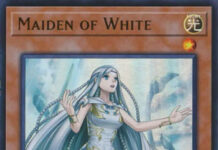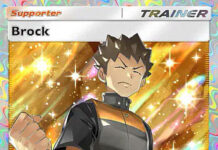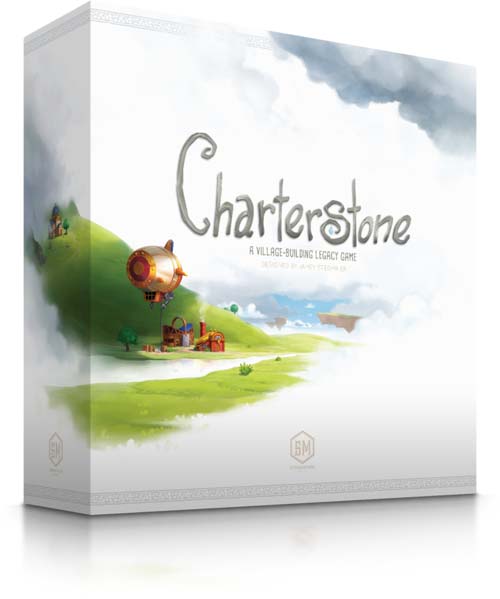
Charterstone is a legacy-style board game from Stonemaier Games. Charterstone combines resource management, worker placement, and city-building with a narrative that evolves over time. It’s designed for 1-6 players and plays over 12 games. Each session introduces new rules, components, and twists that reshape your world and the strategies you’ll use. Think of it like a campaign you play over multiple sittings, and the choices you make will have a lasting impact. Over the course of a campaign, players will modify the game board and unlock new abilities. While the core gameplay is light-to-medium weight, the campaign elements and sense of discovery add a layer of intrigue that keeps things interesting.
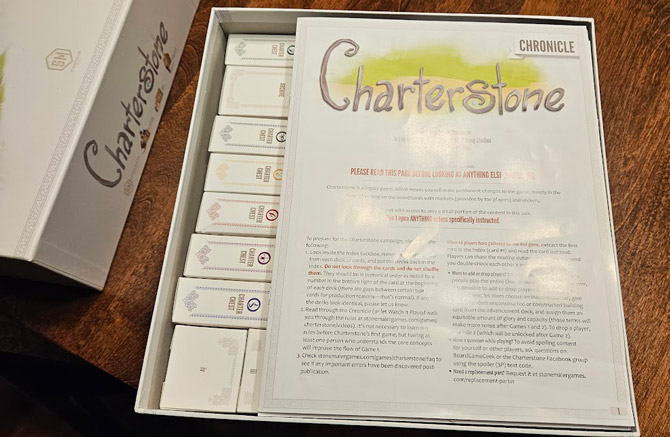
What’s in the Charterstone box?
Charterstone in a fairly large game box. The box is about 11 inches x 11 inches x 4 inches and weighs in at 6 plus pounds! There is a lot of stuff packed inside the box. We don’t want to give too much away because you should experience Charterstone without too many spoilers, but inside you’ll find:
- 1 Large Game Board (two-sided)
- 75+ “crates” to unlock
- 36 metal coins
- 350+ unique cards
- 230+ wooden tokens (meeples, wood, coal, grain, brick, iron, pumpkin, etc.)
- Rulebooks
Stonemaier Games consistently delivers top-notch components, and Charterstone is no exception. The board and pieces are beautifully designed with high-quality materials. The artwork is vibrant and helps immerse you in the world. The game’s structure is neatly laid out, with everything from the rulebook to the game box being user-friendly and accessible. The components are designed to last, so even if you’re playing multiple campaigns, you can expect durability.
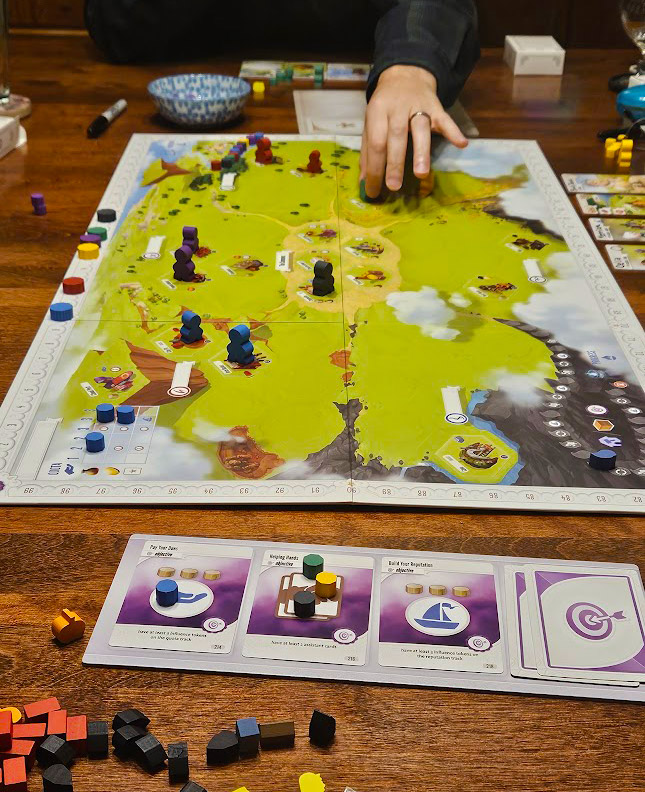
How does Charterstone play?
Charterstone is set in a fictional world where you are tasked with building a prosperous village or “charter” within a new land. The game’s story is told through its evolving components and the decisions you make as you play.
You use a large game board that is fairly lackluster to start. Over the course of the campaign, players will be able to add stickers to the board that create new locations for everyone to visit. Over the course of 12 gaming sessions, your board will look nothing like ours.
Charterstone is a typical worker placement game where players send their workers to different locations on the board to gather resources, build structures, and expand their influence. This is similar to other worker placement type games like Lords of Waterdeep, Viticulture, Agricola, etc. What sets Charterstone apart is its legacy aspect—every action you take and every decision you make unlocks new possibilities for future games, including new rules, buildings, and opportunities.
As you progress through the 12 sessions, you’ll open sealed envelopes that contain new components. These could be extra cards, new rules, or even stickers that alter the board. The excitement of discovering what’s in each envelope is a huge draw. While there’s plenty of replayability in the base game, the real appeal lies in how the game evolves, and how the narrative unfolds. It’s a campaign-style game, so the story builds over time, and your actions carry weight throughout.

Pros, Cons and Final Thoughts for Charterstone
Pros:
- A fresh and exciting legacy experience that mixes worker placement and city-building. Opening boxes, unlocking new components, and watching the Charterstone grow is a genuinely exciting experience.
- Excellent component quality and artwork.
- Constantly evolving game elements make each session feel like a new adventure.
- A nice balance between strategy and story-driven decisions.
- Theme & Art: The visual design is whimsical and charming, and the theme of building a city together is a great fit for the campaign format.
- Player Interaction: While there’s no direct conflict, players can indirectly affect each other’s strategies through worker placement and building competition.
- Six Players! Pojo regulars will know that we are huge fans of games that go up to 6 player counts.
- High replayability thanks to the reset option after completing the campaign. The board is two sided, and you can buy a refresh pack to play it again on the back side. Recharge Packs are available on Amazon.
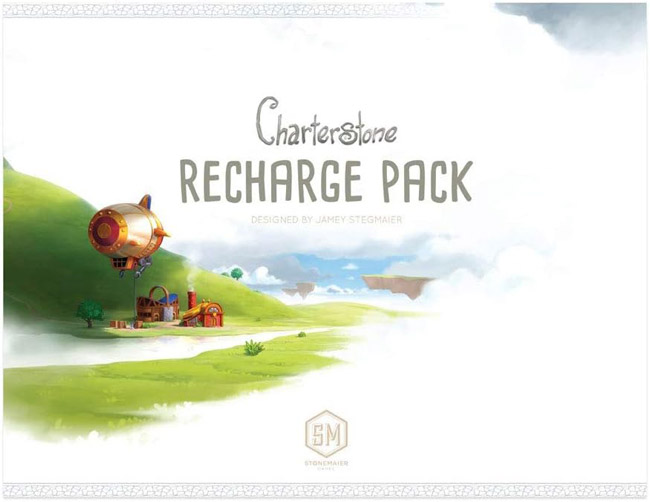
Cons:
- First Game Blues: The rules are relatively straightforward, but there is a fair amount of setup and reading involved for the first game.
- While fun, the theme may not appeal to those looking for a more immersive, character-driven narrative.
- Downtime: With more players, games can start to drag as everyone takes their turns. As you play more games though, people get faster with their turns.
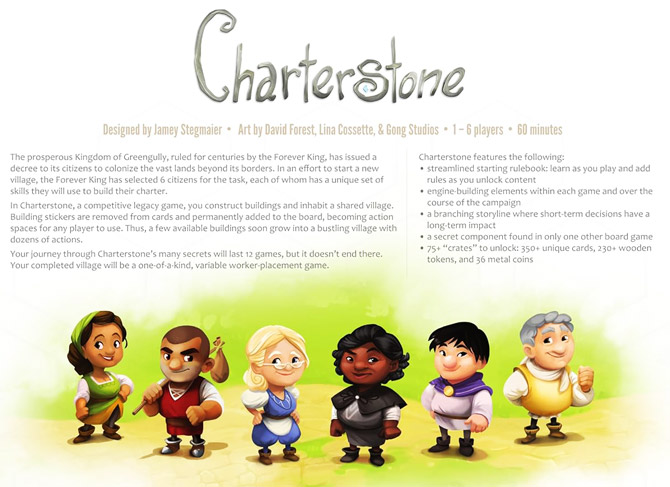
Final Thoughts
While the story is fun and engaging, it isn’t as deeply narrative-driven as some other legacy games, like Gloomhaven or Pandemic Legacy. That said, the gradual unfolding of the narrative through game mechanics is rewarding, and the storyline will captivate most players. If you’re looking for something that can keep your gaming group engaged for a few months, Charterstone is an absolute winner.
Charterstone’s rulebook can feel a bit overwhelming at first, especially for newcomers to legacy games, but once you get into the groove, the flow of the game becomes intuitive. The game is about exploration and discovery, and there’s a real satisfaction in seeing how your village (or “charter”) evolves as you play.
Pojo Verdict 4 out of 5
Charterstone is a great choice for gamers who are looking for a unique and engaging campaign experience. You can buy Charterstone directly from Stonemaier Games, your local board game store, or online stores.
Additional Pojoism to Consider
- The rulebook is a bit weird and fiddly. You sort of build the rulebook as you play. I don’t really love this. The way the rulebook works is that you read numbered cards from a box, and the rules are stickers. After you read each rule card, you peel the stickers off the cards and affix the sticker rules into the rulebook. This way you learn as you go. Sometimes the stickers tell you to look for another card in the box. However, if someone happens to miss text telling them to look for another numbered card in the box everyone might get lost. You would normally look in the rulebook when you are stuck to see what you missed, but in Charterstone, you might have to look and see if you actually pulled all the cards for the story so far. Players might have a rule card in their possession that they didn’t know should have gone into the rulebook. Per our experience, and others at BoardGameGeek, read each card thoroughly. And maybe download the FAQ’s from Stonemaier.


